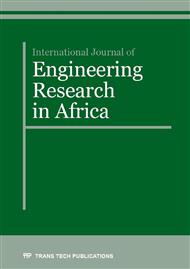[1]
Elwin L. Rooy, Introduction to Aluminum and Aluminum Alloys, ASM Handbook Vol-02.
Google Scholar
[2]
Aluminum Standards, Aluminum Society of America, Washington, DC, (1988).
Google Scholar
[3]
Aluminum Vol. III Fabrication and Finishing, Kent R. Van Horn, ASM, Metals Park, OH, (1976).
Google Scholar
[4]
The Metallurgy of Aluminum and Aluminum Alloys. Robert J. Anderson (ed. ), Henry Carey Baird & Co., Inc. New York, (1925).
Google Scholar
[5]
C.A. Johnson, G.E. Beatty, G.A. Knorovsky, D.L. Kuruzar, H.W. Seeds, D.E. Spindler, J.S. Thrower, R.N. Vecchiarelli, and J.C. Papritan, , Welding processes, American welding socity, USA), American Welding Society, vol. 2, 1991, pp.739-763.
Google Scholar
[6]
C. Maldonado-Zepeda, The effect of interlayers on dissimilar friction weld properties, PhD thesis, University of Toronto, Canada, (2001).
Google Scholar
[7]
G. E. P. Box, and K. B Wilson, On the Experimental Attainment of Optimum Conditions (with discussion), Journal of the Royal Statistical Society Series B 13(1), 1951, pp.1-45.
Google Scholar
[8]
H. Raymond Myers, André I. Khuri and Walter, Response Surface Methodology: 1966–l988, Technometrics, Vol-31 (2), 1989, pp.137-157.
DOI: 10.1080/00401706.1989.10488509
Google Scholar
[9]
M. Kathleen Carley, Y. Natalia Kamneva, Jeff Reminga. Response surface methodology, CASOS Technical report, (2004).
Google Scholar
[10]
R. Paventhan, P.R. Lakshminarayanan, V. Balasubramanian, Prediction and optimization of friction welding parameters for joining aluminum alloy and stainless steel, Transactions of Nonferrous Metals Society of China, 21(7), 2011, pp.1480-1485.
DOI: 10.1016/s1003-6326(11)60884-4
Google Scholar
[11]
M. Sahin, and H.E. Akata, An experimental study on application of friction welding for parts with different diameters and width, The Third International Congress Mechanical Engineering Technologies Sofia, Bulgaria, (2001).
Google Scholar
[12]
S.D. Meshram, T. Mohandas, G. Madhusudhan Reddy, Friction welding of dissimilar puremetals, Journal of Material Processing Technology, 2007, 184: 330-337.
DOI: 10.1016/j.jmatprotec.2006.11.123
Google Scholar
[13]
C.L. Tien, and S.W. Lin, Optimization of process parameters of titanium dioxide films by response surface methodology, Opt. Common, vol. 266, 2006, p.574–81.
DOI: 10.1016/j.optcom.2006.05.044
Google Scholar
[14]
S.T. Selvamani, S. Divagar, M. Vigneshwar, Application of Response Surface Methodology (RSM) in Friction Welding AISI 1020 Grade Steel Joints, International Journal of Engineering Research in Africa, Vol. 16, 2015, pp.38-44.
DOI: 10.4028/www.scientific.net/jera.16.38
Google Scholar
[15]
K. Manonmani, N. Murugan, & G. Buvanasekaran, Effect of process parameters on the weld bead geometry of laser beam welded stainless steel sheets, International Journal of Joining Materials, vol. 17, (4), 2005, pp.103-109.
DOI: 10.1007/s00170-006-0432-7
Google Scholar
[16]
R. Paventhan, P.R. Lakshminarayanan, V. Balasubramanian, Fatigue behavior of friction welded medium carbon steel, Fatigue behavior of friction welded medium carbon steel and austenitic stainless steel dissimilar joints, Materials and Design. 32 (4), 2011, p.1881.
DOI: 10.1016/j.matdes.2010.12.011
Google Scholar


